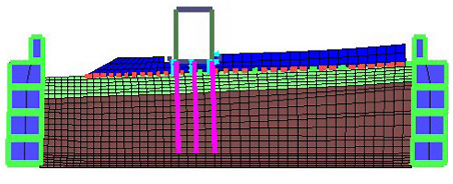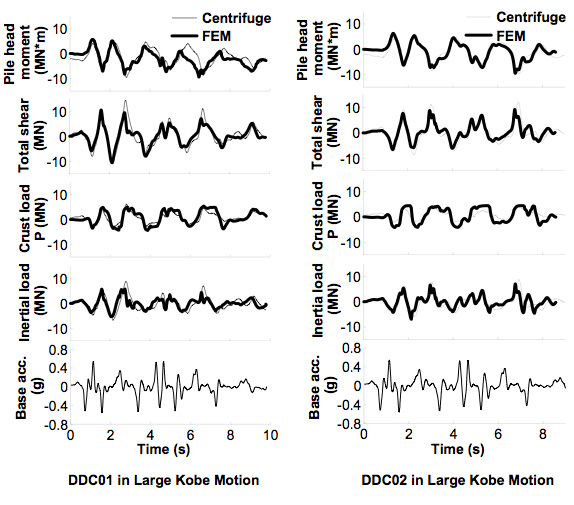Effect of Ground Deformations and Liquefaction on Bridges - 2392005
| Project Title—ID Number | Effect of Ground Deformations and Liquefaction on Bridges - 2392005 |
| Start/End Dates | 10/1/05 – 9/30/06 |
| Funding Source | PEER-CA State Transp. Fund |
| Project Leader (boldface) and Other Team Members | Ross W Boulanger (UCD/F), Alicia Ambrosini (UCD/US), Alex Kan UCD/US), Dongdong Chang (UCD/GS) |
Project goals and objectives
The objective of this project has been to support the Bridge Thrust Area's efforts regarding the simulation and performance of bridges subject to liquefaction and lateral spreading hazards, with particular emphasis on supporting the continuing development of simulation tools, the validation of those simulation tools against physical data, and the continuing development of design procedures and guidelines.
Role of this project in supporting PEER's mission (vision)
This project supports PEER's mission by further developing the knowledge base and enabling technologies necessary for Thrust Area II's application of the PBEE methodology to bridge and transportation systems.
Methodology employed
The project involved: (1) continued support and enhancement of various nonlinear soil spring material models, (2) systematic comparisons of FE models that used the 4-node porous solid, 4- node quad u-p, and 9-node quad u-p elements against centrifuge data, and (3) expanded parametric analyses using the calibrated FE models to address issues in the simplified design procedures being utilized in the test bed and bridge fragility projects.
Brief Description of previous year's achievements, with emphasis on accomplishments during last year (Year 8)
Different FE models have been evaluated against the experimental data from two dynamic centrifuge model tests. Each centrifuge model had a pile-supported structure embedded in soil profile that developed lateral spreading during strong shaking. The deformed FE mesh for one of these models is shown below.

Each centrifuge model had been shaken by a series of four earthquake motions, such that there were a total of eight cases to analyze. The input parameters for the two models were essentially identical except for small differences in the thickness of each soil layer, the fundamental period of the supported superstructure, and the undrained shear strength of the clay crust layer. Analyses have been completed using the 4-node porous solid and 4-node u-p quad elements in OpenSees, while work is ongoing with the 9-node u-p quad elements. The computed responses are compared to the measured responses in terms of acceleration time series, excess pore water pressures, displacements, bending moments, and lateral loads on the pile foundation. The computed time series are compared to measured quantities of the some of the key quantities in the figure below for the two different structural models during a large "Kobe" input motion. The computed and recorded responses are in reasonably good agreement for this and the other cases.

Other similar work being conducted within and outside PEER and how this project differs
This project complements related projects in the Bridge Thrust area. The projects by Kramer/Arduino and Bray/Martin are focused on demonstrating the application of the PEER PBEE methodology against a baseline bridge, and thus their work benefits from the continuing developments and validation efforts described herein. Brandenberg's work on fragility relations will directly use the design procedure he developed during his doctoral studies, and it will benefit from any updates/revisions that are derived from the parametric studies herein and the improvements in the efficiency tools. Boulanger/Kutter's Lifelines project on pile pinning effects in bridge abutments is ending, but any subsequent continuation of this work will benefit from the studies described herein. These overall efforts further benefit and are coordinated with Elgamal's involvement in a US-Japan collaborative project that involves Dobry and Abdoun (MCEER) and NIED researchers from Japan.
Describe any instances where you are aware that your results have been used in industry
The design guidance developed from this and related projects have been utilized by engineers within Caltrans and private firms in California.
Expected milestones & deliverables
We expect to complete the systematic evaluation of alternative FE models and the main body of parametric analyses by the end of this year. The results will be summarized in a final report and journal papers.
Back to Funded Project Archive main page

